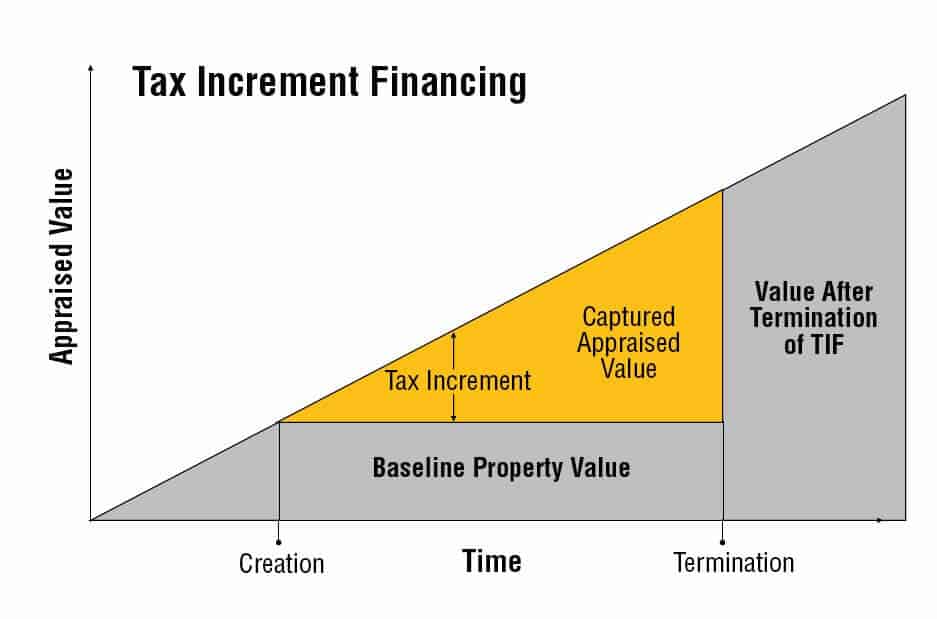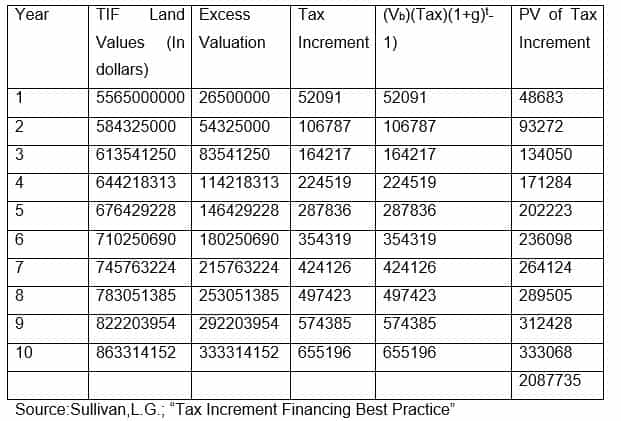Introduction to Tax Increment Financing (TIF)
Tax Increment Financing (TIF) is a popular economic development tool by which the local governments use incremental property tax to fund the public costs of economic revitalization and growth. TIF became an increasingly used tool across the United States and Europe from 1980’s and is still one of the most used tools for enhancing funds for infrastructure financing.
- Tax Increment financing uses increased property taxes that is generated by new development that can be of urban infrastructure such as underground drainage, water supply or stormwater drainage or a hike in Land Value due to a provision of a state of art construction in a designated “blighted” area.
- This increased infrastructure and better facility attract development in form of office buildings, retail industry or housing development, which would otherwise not take place, which increase the social value of the area as well creating a job for the people.

How is Tax Increment Financing Used?
The basic notion behind TIF is as follows:
Step 1: The state government passes the Tax Increment Financing Statutes which enables the urban local bodies across different districts to improve the condition of the infrastructure.
Step 2: The urban local bodies which intend to revitalize the city’s urban infrastructure, determines the areas/zones/pockets across the city that lack or have deteriorated infrastructure. These pockets are identified using the “but-for” test.
- But-For Test: Before an authority may create a TIF district, the urban local body is required to make a “but-for” findings that
- The development “cannot” occur without TIF assistance
- The market value of the TIF development will be higher (after deducting the value of the TIF initiation) that what would be received on the site if TIF were not used.
Step 3: Once areas/pockets/zones have been determined, the urban local body divided these pockets into districts, which are then known as Tax Increment Districts or District Improvement Financing
Step 4: The urban local body then formulates a base valuation of all property in the TIF district, which is then utilized to determine the amount of incremental property tax values over time.
Step 5: The urban local body may secure the funding of the infrastructure through different means, such as floating a bond. In most cases from the US, a bond is floated and repayment is done from the incremental funds collected.
Step 6: Once the infrastructure development comes towards a completion the repayment of the bond starts. The repayment is a central feature and the main notion which separates Tax Increment Financing from public debt.
How is Tax Increment Financing used to pay Initial Costs?
When Tax Increment financing is adopted by an urban local body, the main issue which arises is how the initial costs are going to be paid, as the increments shall be received after the development beings or a certain phase of the same is covered. In this scenario, three financing tools are used to cover these upfront costs, namely:
- Bonds: The urban local body may issue bonds to cover up these upfront costs and use increments to pay for the same. In some cases, it has been observed that the “incremental” funds are received at a much later stage, due to the nature of the infrastructure provided; the urban local body may issue extra bonds to pay interest on the bonds until the “increments” begin to be received.
- Interfold Loans: In some cases, the authority or city may advance money from its own funds and use the increments to recover the income used of the urban local body.
- Pay-as-you-go Financing: In the case where the urban local body employees a developer in a public participation mode, the arrangement could be such that the developer would have to pay the entire cost and the developer is then the “incremental value” is then used to repay for these costs. This type of developer based financing is known as “ Pay-as-you-go Financing”

Types of TIF Districts
| District Type | Use of increment | Maximum Duration |
| Redevelopment | Redevelop blighted areas | 25 years |
| Renewal and Renovation | Redevelop areas with obsolete uses, not meeting blight test | 15 years |
| Economic Development | Encourage Manufacturing and other footloose industries | 8 years |
| Housing | Assist Low and moderate-income housing | 25 years |
| Soils | Clean up contaminated sites | 20 years |
| Compact Development | Redevelop commercial areas with more dense developments | 25 years |
Source: Michael, “House Research”
Calculation of Incremental Values
Step 1: The Land Values are first frozen at the year of implementation of Tax Increment Financing; the property tax is then calculated as per the general method of calculation (In case of the US and Europe, the property tax is collected on the basis of the land values).
Step 2: Determine the total amount of increments collected from the TIF district since its inception or certification. This is defined by the broad value of increments and includes developer repayments of amounts, which are covering the increments, investments earned on the increments, and so forth.
Step 3: Deduct any amount of any excess increments that were distributed in a prior year to the city. This could as well be any payment done by the pocket of the urban local body; such precaution is to be taken in order to avoid any double subtractions.
Step 4: Deduct the entire amount of collections from the tax base attributable to the taxing departments. The amount achieved is the incremental value.
Example Of TIF Calculation
Total Tax Revenue = Vxtaxx (1)
If we assume that some portion of a municipality is designated as a TIF district, and if we further assume that TIF Land Values in excess of the initial, or base, valuation generate tax revenue for the TIF district, then the tax increment can be defined as:
Tax Increment = taxx (VTIF– VBASE) (2)
where the base valuation of the properties confined within the TIF is VBASE and VTIF is the Land Values during succeeding periods. This difference (VTIF – VBASE) is demarcated as the excess valuation of the TIF district. If the annual rate of change in Land Values in the TIF district is defined as gb, then equation 2 can be rewritten as:
Tax Increment = taxx (VBASE(1+ gb)t – VBASE) (3)
and algebraically rearranged as:
Tax Increment = (VBASE)(taxx )((1+gb)t – 1) (4)
Thus, the incremental TIF revenue in a given post-TIF year is the product of the base property valuation of the TIF district (VBASE), the combined municipal tax rate (taxx) and the annual growth in TIF Land Values (gb). A positive relationship exists between these factors and the size of the tax increment with larger factors leading to larger tax increments obtainable for redevelopment. Although all three factors are significant to the total increment spawned, the expected growth rate of TIF Land Values is most crucial to the economic justification of a TIF district. The post-TIF growth rate also determines whether a proposed TIF meets the conditions of financial feasibility and economic efficacy. Dye and Sundberg opinionate out that if pre-TIF growth rates for the designated zone are non-zero, “some efficiency-improving projects will not be financially viable and (some) financially practical projects will not be economically effectual”(1998, p. 96).

The financial viability of a TIF district of life N years, as measured by net present value (NPV), is the summed present value of the tax increment less any TIF organizational or infrastructure costs. The extension of equation 4 is shown as:
Source: Sullivan, L. G.; “Tax Increment Financing Best Practice”
where k represents the cost of funds for the municipality. If NPV is positive, then the proposed TIF district is financially practicable. Positive cash flow is a “necessary condition” for the creation of a TIF district but is not a “sufficient condition.”
To illustrate, assume the following:
A city is considering the creation of a Tax Increment Financing district in which current total Land Values (less exemptions) are $530 million. The combined municipal tax rate is $1.9657 per $1000 of valuation. If the TIF district is created, all taxing authorities will participate. The city will spend $1 million initially in infrastructure improvements on the district that will generate a post-TIF growth rate in Land Values of 5 percent. Assume a 10-year life for the TIF district and a municipal bond rate for the city of 7 percent. Table 1 details the expansion of equation 5 for this example.
Column 2 (of Table 1) shows the growth in TIF Land Values over the 10-year project life. The figures in column 3 reflect the excess valuation of property or the combined Land Values above the base value. The tax increment for each year (equation 2) is provided in column 4. The tax increment recomputed using equation 4 in column 5, is equivalent to the values generated in column 5. The present value (at 7 percent) of each tax increment is shown in column 6 with the summed present value of $2,087,735 indicated at the bottom of the column. This value ($2,087,735) represents the present value of the tax revenue that the TIF district would generate over the ten-year life of the project. The net present value of the TIF district would be the benefits less the initial cost, or:
NPV(TIF) = $2,087,735 -$1,000,000
= $1,087,735.

Hence the NPV arrived at is $2087735, and hence a total value more than what has been invested. Therefore, a TIF district may yield lower growth rates over its life than the historical rates and still be financially viable.
Author: This article forms a part of Infrastructure Financing through Tax Increment Financing: A Case Study of Vijayawada by Amrita Bhatnagar. Amrita did her bachelor degree in Planning from School of Planning & Architecture, Vijayawada. During her studies, many of her papers were published on various platforms. Economics & Urban Planning adds to her list of interest, she is an avid writer. During her college days she served at NOSPlan as Chief Editor & one of the founding member of Editorial Board at NOSPlan later she worked at Jones Lang Lasalle (JLL) & is currently associated with Center for Science & Environment (CSE).
Read about: Infrastructure Financing through land, Transit Oriented Development, Cluster Development,